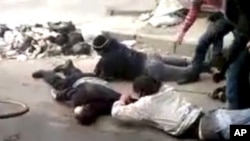Reports from Syria say military defectors killed at least 27 soldiers Thursday in intensifying bouts of armed resistance against embattled President Bashar al-Assad. At least a half dozen anti-government protesters also were killed across the country on the fifth day of an opposition-led general strike.
An escalating insurgency pitting growing bands of Syrian Army defectors against their former comrades has left several Assad loyalists dead. The heaviest fighting took place outside the southern city of Dara'a, where an anti-government rebellion first began in March.
Similar clashes were reported both Tuesday and Wednesday in the northern border province of Idlib, as well as the besieged central city of Homs, and in towns surrounding Dara'a. A group calling itself the “Free Syrian Army” has been spearheading the growing number of clashes.
Syrian opposition sources put the number of defectors at anywhere from 5,000 to 20,000 soldiers, out of a military force of 400,000 men. Middle east analyst Peter Harling of the International Crisis Group said there are small but growing numbers of defectors:
"You have a steady flow of low-level defections," said Harling. "The numbers are gradually picking up. Now, you don't see units defecting, and that would make far more of a difference on the ground. So, you have this trickle of defectors feeding into what now is a nascent insurgency across the country. Armed groups are being formed on a local basis, most often out of civilians.”
Meanwhile, an 88-page report by Human Rights Watch describes “direct and standing orders” by Syrian military and secret police commanders to “use lethal force” against protesters during the uprising.
The report, which includes the testimony of soldiers and officers who defected from Syria's security forces, said that violence was “directly ordered, authorized, or condoned at the highest levels” of the regime. Nadim Houry of HRW in Beirut details those orders:
“Contrary to what President Bashar al-Assad has stated in his recent interview with Barbara Walters [of ABC News in the United States], there were orders to shoot at unarmed protesters and there were orders to detain arbitrarily many of the protesters, and there were orders to torture," said Houry. "It's no accident. It's not the act of a few rogue officers that more than 5000 people have been killed and tens of thousands have been detained.”
Houry said witnesses told Human Rights Watch that commanders handed out live ammunition to soldiers and ordered them to disperse protests “by any means possible.” He added that defectors described instances where intelligence officers shot “soldiers who refused to open fire or who fired in the air.”
Analyst Harling said, however, that growing ranks of defectors are now often inflicting casualties on government forces that “exceed the number of victims among protesters.” He added that the “dynamics on the ground appear to be shifting in favor of the insurgency.”
Harling insists that he sees “ominous trends” pointing to “regionalization of the Syrian conflict.” Despite those trends, though, he argues there is “no strong, tangible evidence that a regional proxy war has started yet.” Syrian forces, meanwhile, continue to target defectors whom they see as a growing threat.
| Join the conversation on our social journalism site - Middle East Voices. Follow our Middle East reports on Twitter and discuss them on our Facebook page. |










